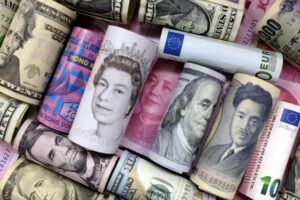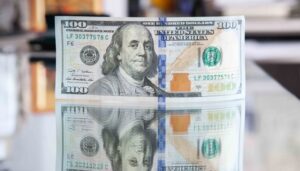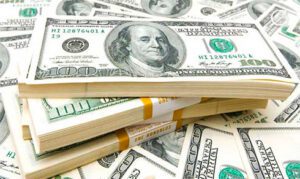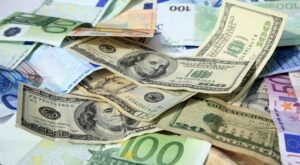
The dollar is moderately declining against the euro, but growing against the Japanese yen, renewing its maximum value in 24 years.
The ICE-calculated index, which shows the performance of the US dollar against six currencies (the euro, Swiss franc, yen, Canadian dollar, pound sterling and the Swedish krona), is practically unchanged on Wednesday morning, as is the broader WSJ Dollar.
The euro/dollar pair is trading at $0.9721 by 8:52 p.m. compared to $0.9707 at the close of the session on Tuesday, the euro adds about 0.1%.
Meanwhile, the rate of the American currency against the yen rose by almost 0.3% and amounted to 146.25 yen compared to 145.86 yen the day before. This is the highest rate since August 1998. The last time the yen fell to a 24-year low at the end of September, after which the Japanese Ministry of Finance intervened in the foreign exchange market to support the national currency.
The dollar is strengthening against the yen due to mixed monetary policy rates: while the Fed is actively raising interest rates, the Bank of Japan continues to adhere to extremely soft monetary policy.
The pound rose 0.4% to $1.1012 compared to $1.0968 at the close of the previous session.
Traders are evaluating conflicting signals about the Bank of England’s emergency government bond purchase program.
British Central Bank Chairman Andrew Bailey said that the regulator will complete the purchase of bonds on Friday, as planned. “The essence of interventions to stabilize financial markets is partly that this is a temporary phenomenon,” he said.
However, the Financial Times then wrote, citing three anonymous sources, that the Central Bank privately hinted to representatives of some banks about the possibility of extending the bond purchase program in order to protect UK pension funds from losses.

The dollar is moderately rising against a basket of major world currencies on Tuesday morning, strengthening for the fifth session in a row on expectations of new rate hikes by the Federal Reserve.
The ICE-calculated index, which shows the dynamics of the US dollar against six currencies (the euro, the Swiss franc, the yen, the Canadian dollar, the pound sterling and the Swedish krona), is growing by 0.24%, the broader WSJ Dollar – by 0.22%.
The euro/dollar pair is trading at $0.9687 by 8:53 pm compared to $0.9704 at the close of the session on Monday, the euro is losing about 0.2%.
The exchange rate of the US currency against the yen is 145.79 yen compared to 145.72 yen the day before, keeping close to the highest level in 24 years, which provokes expectations of new interventions to support the yen from the Japanese government.
The pound fell 0.3% to $1.1028 compared to $1.1057 at the close of the previous session.
By the beginning of next year, the level of the key interest rate in the US may slightly exceed 4.5%, according to the chairman of the Federal Reserve Bank (FRB) of Chicago, Charles Evans. According to him, the Fed will need to keep rates high for some time to cool the economy and the labor market.
Meanwhile, Fed Vice Chair Leil Brainard on the eve noted the need for tightening monetary policy to slow inflation, but added that the central bank’s decisions would depend on incoming statistical data.
The dollar also supports the demand for defensive assets, which increased after the speeches of the heads of the International Monetary Fund and the World Bank. In a joint event on Monday, they warned of rising risks of a global recession amid slower growth in advanced economies, record inflation and rising interest rates.
The IMF estimates that countries that account for about a third of global GDP will face at least two quarters of economic decline this year and next, and by the end of 2026 the global economy will lose about $4 trillion.

The US dollar is stable against major world currencies on Friday morning ahead of the publication of data on the US labor market.
The ICE-calculated index showing the dynamics of the US dollar against six currencies (the euro, the Swiss franc, the yen, the Canadian dollar, the pound sterling and the Swedish krona), as of 8:20 am CST, fell by 0.05%, the broader WSJ Dollar – by 0 .04%.
The euro/dollar pair is trading at $0.9799 compared to $0.9793 at the close of the session on Thursday, the euro adds about 0.06%.
The exchange rate of the US currency against the Japanese is 145 yen compared to 145.14 yen the day before. The so-called offshore yuan (traded in Hong Kong) dropped against the dollar to 7.1022 yuan per $1 from 7.0853/$1 the day before.
The pound rose 0.02% to $1.1164 compared to $1.1162 at the close of the previous session.
The market is waiting for the publication of data on unemployment in the US for September, which may indicate the “health” of the country’s labor market and determine the expectations of traders regarding the further trajectory of monetary policy.
Experts believe that the unemployment rate in the country in September remained at the August mark of 3.7%, and the number of new jobs increased by 250 thousand, writes Trading Economics. The report of the Ministry of Labor will be published at 15:30 CST.

The US dollar is moderately declining against major world currencies on Thursday morning, investors evaluate the statements of the Federal Reserve Board and statistical data.
The ICE-calculated index, which shows the dynamics of the US dollar against six currencies (the euro, the Swiss franc, the yen, the Canadian dollar, the pound sterling and the Swedish krona), is down 0.2%, the broader WSJ Dollar is down 0.25%.
The euro/dollar pair is trading at $0.9920 by 9:08 Moscow time compared to $0.9885 at the close of the session on Wednesday, the euro adds about 0.35%.
The exchange rate of the American currency against the yen is reduced by 0.1% and amounts to 144.53 yen compared to 144.69 yen the day before.
The pound rose 0.1% to $1.1335 compared to $1.1327 at the close of the previous session.
The day before, the head of the Federal Reserve Bank of Atlanta, Rafael Bostic, said that he supports raising the key interest rate in the US by another 125 basis points by the end of the year, to 4.5%.
Meanwhile, San Francisco Fed colleague Mary Daly told CNN that the central bank should raise borrowing costs even higher and keep them high until inflation starts approaching 2%.
It became known yesterday that the index of business activity in the US services sector (ISM Non-Manufacturing) in September decreased to 56.7 points compared to 56.9 points a month earlier, data from the Institute of Supply Management (ISM) showed. Analysts, on average, assumed a more significant drop, to 56 points, according to Trading Economics.
Now all the attention of market participants is directed to data on the US labor market, which will be published on Friday. Experts believe that the unemployment rate in the country in September remained at the August mark of 3.7%, and the number of new jobs increased by 315 thousand people.

The dollar strengthens against the euro, yen and pound sterling in trading on Wednesday after a sharp decline the day before amid signals of a gradual decline in activity in the US economy.
Investors are waiting for data on the US labor market, which is expected to show a slowdown in job growth in the country. The consensus forecast of experts surveyed by Market Watch suggests that the number of jobs in September increased by 275 thousand (315 thousand in August), while maintaining unemployment at 3.7%.
The US Department of Labor will release the data on Friday at 3:30 p.m.
Another report from the Department of Labor, which was published on Tuesday, showed a sharp decrease in the number of open vacancies in the States in August. The indicator fell by 10% – the fastest pace since the start of the pandemic in 2020, to 10.1 million vacancies.
Weak statistics on the US economy are a good signal for risk appetite, as they speak in favor of a reduction in the trajectory of the Federal Reserve (Fed) rate hike, said Steven Innes, managing partner at SPI Asset Management.
Some “cooling” of the labor market will help ease inflation in the US and may reduce the need for further sharp tightening of monetary policy by the Fed, writes Dow Jones.
“If this trend continues, the Fed may back off somewhat in terms of rate hikes later this year and early next year,” said Jack Janasiewicz, portfolio manager at Natixis Investment Managers Solutions.
The euro/dollar pair is trading at $0.9966 on Wednesday, compared to $0.9987 at the close of previous trading. The pound fell to $1.1435 from $1.1475 at the close of previous trading.
The US dollar against the yen is 144.25 yen against 144.14 yen the day before.
On Tuesday, the dollar lost 1.7% against the euro, 1.4% against the pound and 0.3% against the yen.

The ICE-calculated index showing the dynamics of the dollar against six currencies (the euro, the Swiss franc, the yen, the Canadian dollar, the pound sterling and the Swedish krona) loses 0.11% during trading, the broader WSJ Dollar Index – 0.08%.
The euro/dollar pair is trading at $0.9846 compared to $0.9825 at the close of previous trading. The pound rose to $1.1361 compared to $1.1322 at the close of previous trading.
The US dollar against the yen is 144.75 yen against 144.56 yen the day before.
On Monday, the dollar lost 0.2% against the euro, 1.4% against the pound and 0.1% against the yen.
The weakening of the US currency was facilitated by statistical data showing a decrease in the index of business activity in the US manufacturing sector in September to the lowest level since May 2020. They were taken by the market as a signal that the Fed would have to stop the rate hike cycle earlier than expected in order to avoid a sharp decline in economic activity, Trading Economics notes.
The ISM Manufacturing Index fell to 50.9 last month from 52.8 a month earlier, according to the Institute for Supply Management (ISM). Analysts on average expected it to fall to 52.2 points, according to Trading Economics.
On Friday, September data on the US labor market will be released, which is expected to show a slowdown in US job growth. The consensus forecast of experts polled by Market Watch assumes an increase in the number of jobs in September by 275 thousand (315 thousand in August), while maintaining unemployment at 3.7%.
The dollar-denominated ICE index rose 7.2% in the third quarter, the biggest quarterly jump since 2015, according to Dow Jones data. In September, its value increased by 3.2%. The dynamics of the index for the whole of 2022 may be the best since 2014, when it grew by almost 13%.